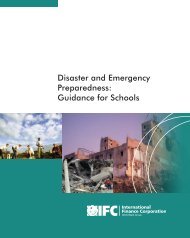Fragile States: Defining Difficult Environments for Poverty ... - INEE
Fragile States: Defining Difficult Environments for Poverty ... - INEE
Fragile States: Defining Difficult Environments for Poverty ... - INEE
Create successful ePaper yourself
Turn your PDF publications into a flip-book with our unique Google optimized e-Paper software.
<strong>Fragile</strong> <strong>States</strong>: <strong>Defining</strong> <strong>Difficult</strong> <strong>Environments</strong> <strong>for</strong> <strong>Poverty</strong> Reductionchallenges of administrative capacity are likely to be exacerbated instates where HIV/AIDS is prevalent.• Political instability: In other states, the government’s ability to rule iscompromised by political instability shown in frequent change inleaders through either constitutional or unconstitutional means,including coups d’etat (e.g. Central African Republic 2003).• Neo-patrimonial politics: In states where administrative systemshave become dominated by in<strong>for</strong>mal or neo-patrimonial politics, thestate institutions may be unable to project sufficient administrativecapacity to carry out even basic state functions (e.g. Indonesia underSoeharto). In such cases of pervasive clientelism, the political logic ofthe system diverts state authority from the stated policy goals to thepursuit of private wealth and power. 4• Conflict: In states with fragile political institutions, governments mayhave difficulty managing the increasing, and often conflicting, demandsplaced upon them. 5 Where political processes break down, eithersporadic or persistent civil conflict can arise, which can furtherundermine public institutions and political processes.• Repressive polities: Finally, there are states that are highly effectivein some senses, but repressive or unresponsive to their people, thusundermining sustainable development and sowing the seeds <strong>for</strong> futurefailure. These different types of state weakness overlap and interact;yet it is important to draw analytical distinctions where possible to<strong>for</strong>mulate more effective policy responses.4. Multiple definitions. It is easier to list the problems associated with stateweakness than to produce a definitive and agreed list of ineffective states.There is a consensus 6 that states fall on a continuum from stronger toweaker per<strong>for</strong>mance, and that states can move quickly in and out of crisis.Which states are defined as weak, and the factors by which weakness isrecognised will depend in part on the observer’s policy agenda. Somestates are ineffective at controlling terrorism but reasonably good atproviding basic health care; other states maintain excellent diplomaticrelations but are unable to contain internal civil unrest. Some definitions ofhave focused narrowly on those states affected by armed conflict, whileother definitions include states affected by poor governance, corruption,and low administrative capacity. In many cases, governments enduringthe strains of a hostile international environment and weak capacity athome have struggled just to ensure state survival, so survival alone maybe seen as an accomplishment. 7 At a time when <strong>for</strong>ces of globalisation4 Cf. van de Walle (2001), Bayart, Ellis and Hibou (1998), and Chabal and Daloz (1998).5 Putzel (2003).6 Although some authors (e.g. Bilgin & Morgan 2002) have argued that the terminology ofstate weakness or failure is unhelpful, they do not offer an analytically superior alternative.7 Clapham (1996).This working paper is intended to stimulate public discussion. It is not necessarilyDFID or UK Government policy6
















